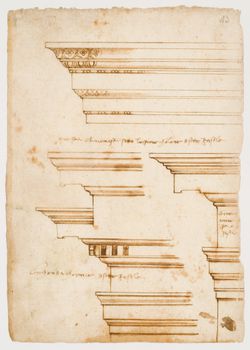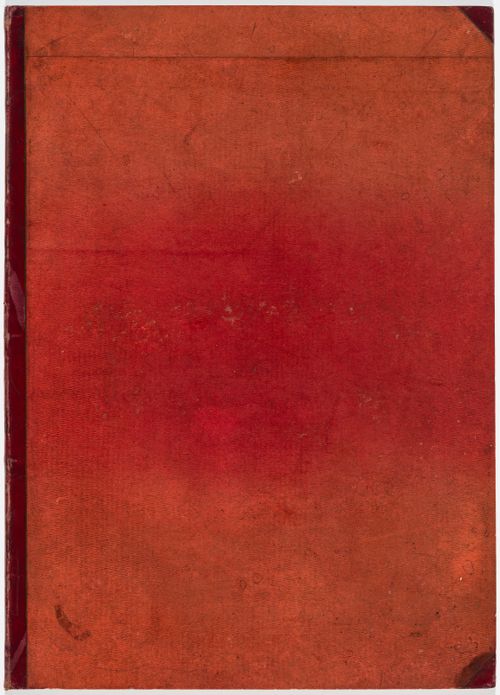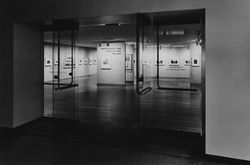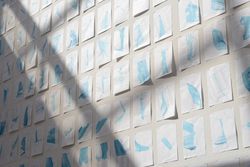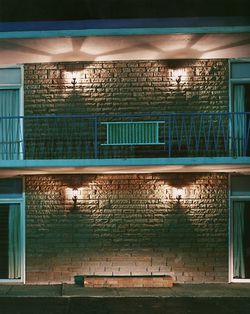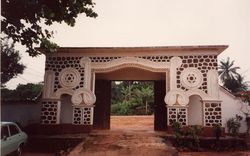Les individus agissent comme leurs propres historiens, en masquant certaines histoires et en mettant l’accent sur d’autres. Mais à l’échelle des nations et des cultures, et surtout dans cette époque de la mémoire numérique omniprésente, il est devenu plus difficile d’oublier. S’appuyant sur la question de l’histoire et de ses usages, soulevée par des expositions comme(...)
Johannes Grenzfurthner
12 avril 2018
Venez oublier la contre-culture, avec Johannes Grenzfurthner
Actions:
Description:
Les individus agissent comme leurs propres historiens, en masquant certaines histoires et en mettant l’accent sur d’autres. Mais à l’échelle des nations et des cultures, et surtout dans cette époque de la mémoire numérique omniprésente, il est devenu plus difficile d’oublier. S’appuyant sur la question de l’histoire et de ses usages, soulevée par des expositions comme(...)
Johannes Grenzfurthner
Cara Rachele, chercheure en résidence 2016, présente ses recherches: Cette conférence se penche sur l’explosion de dessins détaillés produits pendant la Renaissance. Elle établit le lien entre l’émergence, au XVIe siècle, du détail devenu un canon du dessin et l’évocation de l’antique matériel. L’évolution organique de la façon de dessiner les détails transparaît dans(...)
11 août 2016, 18h
Séminaire de chercheur en résidence : Cara Rachele
Actions:
Description:
Cara Rachele, chercheure en résidence 2016, présente ses recherches: Cette conférence se penche sur l’explosion de dessins détaillés produits pendant la Renaissance. Elle établit le lien entre l’émergence, au XVIe siècle, du détail devenu un canon du dessin et l’évocation de l’antique matériel. L’évolution organique de la façon de dessiner les détails transparaît dans(...)
DR1974:0002:004:001-022
Description:
- This book contains 8 pages of text primarily describing projects by Charles Rohault de Fleury for the Muséum national d'histoire naturelle. The text is followed by a lithograph after Lemaitre, which depicts the exterior of the "serres chaudes", and by 14 prints engraved/etched by Marlier depicting the buildings designed by Rohault de Fleury for the Muséum national d'histoire naturelle between 1833 and 1839. The "serres chaudes" are illustrated by 8 prints: interior perspectives, plans, elevations, sections and details of the prefabricated columns. Four prints are included for the Galerie de minéralogie et de géologie, the monkey house and the reservoirs - mostly elevations, plans and sections. Also included is a site plan of the Muséum national d'histoire naturelle and one print of comparative examples - mostly plans, sections and details - of English "serres chaudes", including the Warm House and the Temperate House at the Colosseum in London, the Temperate House at the Royal Botanic Gardens in Kew, Camellia House and Palm House at Loddiges Nursery in Hackney, and a glasshouse with a semidome, also in Hackney.
architecture, architecture de paysage, ingénierie
published 1837
MUSÉUM / D'HISTOIRE NATURELLE / SERRES CHAUDES, / GALERIE DE MINÉRALOGIE, / ETC. ETC. / PAR. CH. ROHAULT FILS, / ARCHITECTE DU MUSÉUM, ANCIEN ÉLEVE DE L'ECOLE POLYTECHNIQUE
Actions:
DR1974:0002:004:001-022
Description:
- This book contains 8 pages of text primarily describing projects by Charles Rohault de Fleury for the Muséum national d'histoire naturelle. The text is followed by a lithograph after Lemaitre, which depicts the exterior of the "serres chaudes", and by 14 prints engraved/etched by Marlier depicting the buildings designed by Rohault de Fleury for the Muséum national d'histoire naturelle between 1833 and 1839. The "serres chaudes" are illustrated by 8 prints: interior perspectives, plans, elevations, sections and details of the prefabricated columns. Four prints are included for the Galerie de minéralogie et de géologie, the monkey house and the reservoirs - mostly elevations, plans and sections. Also included is a site plan of the Muséum national d'histoire naturelle and one print of comparative examples - mostly plans, sections and details - of English "serres chaudes", including the Warm House and the Temperate House at the Colosseum in London, the Temperate House at the Royal Botanic Gardens in Kew, Camellia House and Palm House at Loddiges Nursery in Hackney, and a glasshouse with a semidome, also in Hackney.
architecture, architecture de paysage, ingénierie
Le chercheur en résidence Nader Vossoughian se penche sur l’urbanisme informel dans l’histoire de l’encyclopédisme, en utilisant comme étude de cas le Whole Earth Catalog. Cliquez ici pour lévénement Facebook.
Maison Shaughnessy
Presenté en anglais Mot(s)-clé(s):
Nader Vossoughian, chercheur en résidence, séminaire
9 août 2012 , 18h
Séminaire de chercheur en résidence : Nader Vossoughian
Actions:
Description:
Le chercheur en résidence Nader Vossoughian se penche sur l’urbanisme informel dans l’histoire de l’encyclopédisme, en utilisant comme étude de cas le Whole Earth Catalog. Cliquez ici pour lévénement Facebook.
Maison Shaughnessy
Presenté en anglais Mot(s)-clé(s):
Nader Vossoughian, chercheur en résidence, séminaire
Meetings and News Releases
ARCH203210
Description:
Publications et extraits de publications dans lesquels fut publié le communiqué de presse invitant la population à participer à la levée de fonds (1966-1967); texte de Przygoda sur l'histoire des Polonais adressé au Congrès Canadien polonais (1966); brouillon du texte de la circulaire annoté; correspondance (1966); minutes du comité du monument (1966); coupures de journaux et publications (1966); "mailing list for news releases, 1966"; communiqué de presse (1966); notes manuscrites.
avril 1966 à juin 1967
Meetings and News Releases
Actions:
ARCH203210
Description:
Publications et extraits de publications dans lesquels fut publié le communiqué de presse invitant la population à participer à la levée de fonds (1966-1967); texte de Przygoda sur l'histoire des Polonais adressé au Congrès Canadien polonais (1966); brouillon du texte de la circulaire annoté; correspondance (1966); minutes du comité du monument (1966); coupures de journaux et publications (1966); "mailing list for news releases, 1966"; communiqué de presse (1966); notes manuscrites.
avril 1966 à juin 1967
Mrinalini Rajagopalan retrace l’histoire du Fort rouge à Delhi, de sa destruction par les Britanniques en 1857, jusqu’à leurs efforts déployés pour préserver et protéger l’édifice. Cliquez ici pour consulter la liste complète des séminaires de l’été.
Maison Shaughnessy
8 juillet 2010
Séminaire de chercheur en résidence : Mrinalini Rajagopalan
Actions:
Description:
Mrinalini Rajagopalan retrace l’histoire du Fort rouge à Delhi, de sa destruction par les Britanniques en 1857, jusqu’à leurs efforts déployés pour préserver et protéger l’édifice. Cliquez ici pour consulter la liste complète des séminaires de l’été.
Maison Shaughnessy
En 1982, le CCA organise sa première exposition, Photographie et architecture : 1839–1939, avant même que soit construit l’actuel bâtiment abritant le musée. L’exposition est présentée à la Galerie Lempertz Contempora à Cologne (1982), à l’Art Institute of Chicago (1983), au Cooper-Hewitt National Design Museum à New York (1983), au Centre Georges-Pompidou à Paris (1984)(...)
15 septembre 1982 au 16 octobre 1982
Photographie et architecture : 1839–1939
Actions:
Description:
En 1982, le CCA organise sa première exposition, Photographie et architecture : 1839–1939, avant même que soit construit l’actuel bâtiment abritant le musée. L’exposition est présentée à la Galerie Lempertz Contempora à Cologne (1982), à l’Art Institute of Chicago (1983), au Cooper-Hewitt National Design Museum à New York (1983), au Centre Georges-Pompidou à Paris (1984)(...)
Quand Gordon Matta-Clark se procure les titres de propriété et la documentation d’une douzaine de petites parcelles non occupées à New York entre 1974 et 1977 (qui, en 1992, ont fait l’objet d’une exposition intitulée Reality Properties: Fake Estates), il n’a pas d’intention précise – autre que sa conviction suivant laquelle « l’existence de lots vacants et sous-utilisés(...)
Théâtre Paul-Desmarais
22 septembre 2016, 18h
Nicholas de Monchaux : Local Code
Actions:
Description:
Quand Gordon Matta-Clark se procure les titres de propriété et la documentation d’une douzaine de petites parcelles non occupées à New York entre 1974 et 1977 (qui, en 1992, ont fait l’objet d’une exposition intitulée Reality Properties: Fake Estates), il n’a pas d’intention précise – autre que sa conviction suivant laquelle « l’existence de lots vacants et sous-utilisés(...)
Théâtre Paul-Desmarais
Barbara Penner, historienne de l’architecture, retrace l’évolution des Chutes du Niagara, de leur statut de destination phare pour jeunes mariés au XIXe siècle à celui d’icône postindustrielle kitsch, avant de redevenir la destination par excellence des jeunes mariés. Le photographe Alec Soth, dont les travaux constituent l’amorce de cette causerie présentée par Barbara(...)
Théâtre Paul-Desmarais
23 avril 2009
L'enseignement de... Niagara Falls
Actions:
Description:
Barbara Penner, historienne de l’architecture, retrace l’évolution des Chutes du Niagara, de leur statut de destination phare pour jeunes mariés au XIXe siècle à celui d’icône postindustrielle kitsch, avant de redevenir la destination par excellence des jeunes mariés. Le photographe Alec Soth, dont les travaux constituent l’amorce de cette causerie présentée par Barbara(...)
Théâtre Paul-Desmarais
articles
Où n’y avait-il pas de modernisme?
Ikem Stanley Okoye redéfinit les origines du modernisme africain
Actions:

